Types and Applications of Electric Paint Sprayers
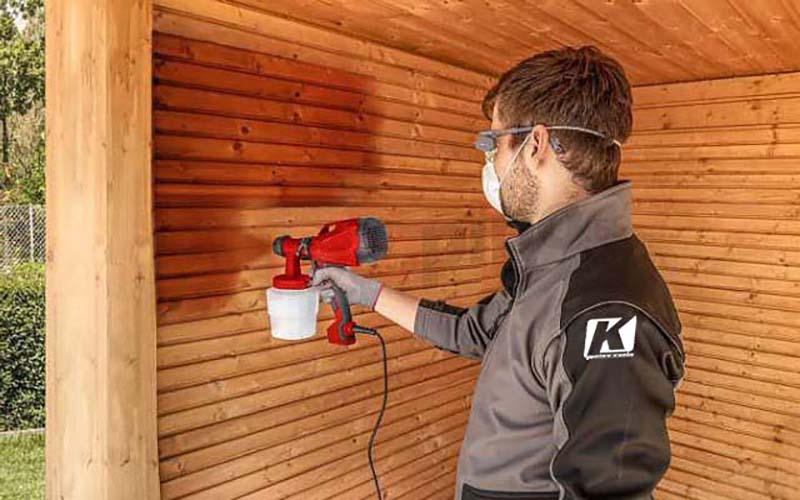
electric paint sprayer
Types and Applications of Electric Paint Sprayers
Painting jobs usually enjoy the appetite of many amateurs who take advantage of a weekend or even their vacations to get down to work and change the face of their home. For their part, professional painters or operators of various tasks such as blacksmithing, plating, carpentry and others that involve the application of paint, are always looking for means and tools that facilitate their task and increase productivity.
It is very true that today's technology has developed numerous paint application devices that are leaving behind the traditional brush and roller methods. Those engaged in auto body and paint jobs, for example, have pneumatic paint sprayers that achieve a perfect finish in just a few hours. Like any pneumatic tool, paint sprayers only need the inevitable workshop compressor to provide them with the air they need to work.
One wonders if paint sprayers are also marketed as power tools, in order to be available to other users (for example, at home) who do not have a compressor and do not want to buy or rent it for a painting job. In that case, this article will give us good news, because here we will learn about electric paint spray systems or simply paint spray guns that we can buy commercially at a reasonable cost.
How does an electric paint sprayer work?
The secret of any sprayer is to produce the atomization of the fluid to be sprayed, that is, to convert it into small droplets that are the ones that form a fan spray pattern.
There are several ways to achieve the atomization of this fluid, in our case, paint or related materials. Thus, while pneumatic sprayers inject compressed air into the paint, electric guns pump the paint at high pressure through a motor, quickly expelling it through a nozzle. The following figure shows the atomizing process produced by an electric spray gun.
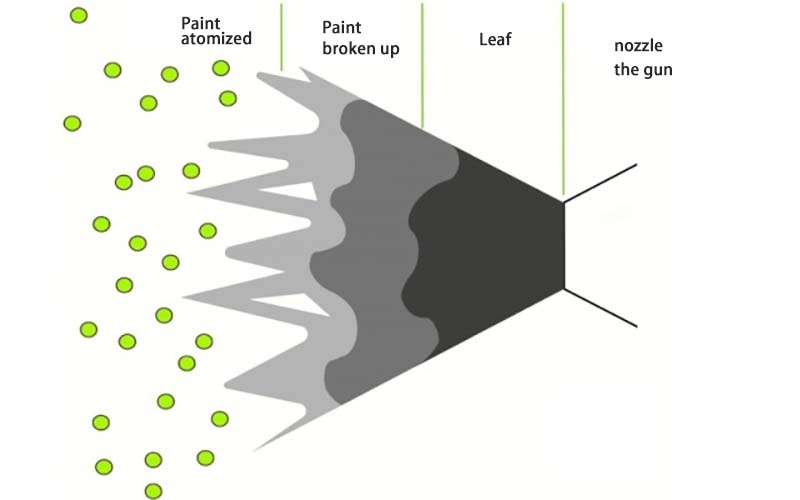
Paint Atomization
The high pressure forces the paint through the device's small nozzle, emerging as a solid stream (known as a "foil") at high speed. When that solid jet hits the air it begins to disintegrate, breaking initially into fragments and ultimately into very small droplets that form the fan pattern.
The advantages of electric paint sprayers are several, but professionals and amateurs point to these three as the main ones:
Speed – They are faster than pneumatic tires, so more jobs can be completed in less time and with less labor, without relying on a compressor. Compared to traditional methods, they are up to 10 times faster than brushes and rollers.
Quality: They produce an even coat of paint on all types of surfaces, leaving a consistent, high-quality finish.
Versatility – They can be used for a wide range of coating materials, including interior and exterior jobs, and can be easily transported from one location to another.
What is an electric paint sprayer system?
Like any system, you can expect there to be several components in addition to the spray gun itself. To this end, this illustrative video shows us one by one those components.
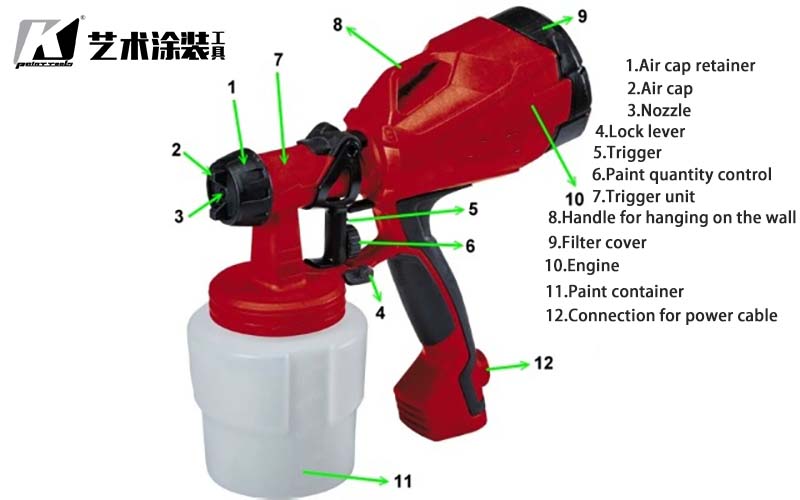
Spray Gun – Parts
1.Air cap retainer
2.Air cap
3.Nozzle
4.Lock lever
5.Trigger
6.Paint quantity control
7.Trigger unit
8.Handle for hanging on the wall
9.Filter cover
10.Engine
11.Paint container
12.Connection for power cable
The system is completed with the delivery of one or more spare nozzles, a brush, a nozzle cleaning needle or punch with its corresponding “T” adapter and a paint viscosity measuring container, which we will see later. why and how it should be used. Of all these components, we are going to deal with a little more than two: the motor and the mouthpiece.
Engine Types
Depending on the manufacturer, the motors included in electric paint sprayers can be of three types: universal, alternating current or direct current, in the latter case, with or without brushes.
Universal motors are the cheapest, but due to the high number of revolutions per minute they present (between 10,000 and 20,000), and despite being fan-cooled, they have the shortest useful life. On the other hand, AC motors, although they last longer, need a constant and permanent power supply to work properly, and can overheat if used in certain circumstances.
For this reason, DC motors are generally preferred, which better withstand power fluctuations because they can run at variable speeds. Within these, we have sprayer models equipped with motors with carbon brushes and brushless models, that is, equipped with brushless motors. The latter are heavier and more expensive, but offer a number of advantages and reduced maintenance compared to their brush-equipped peers.
Although the vast majority of electric paint sprayers are corded models, we will also find cordless battery-powered sprayers, which, like so many other electric tools, have comfortably established themselves on the market. In Of Machines and Tools we have already pointed out the particularities of corded and cordless tools, and in this article we present a summary in this regard, according to which each user will be able to choose the technology of his convenience.
Nozzle:
This small interchangeable part shown in the figure below has a great role in the system, since: Determines the fluid flow, that is, the amount of paint applied. It determines the spray pattern (fan width), so selecting the correct tip is an important decision.
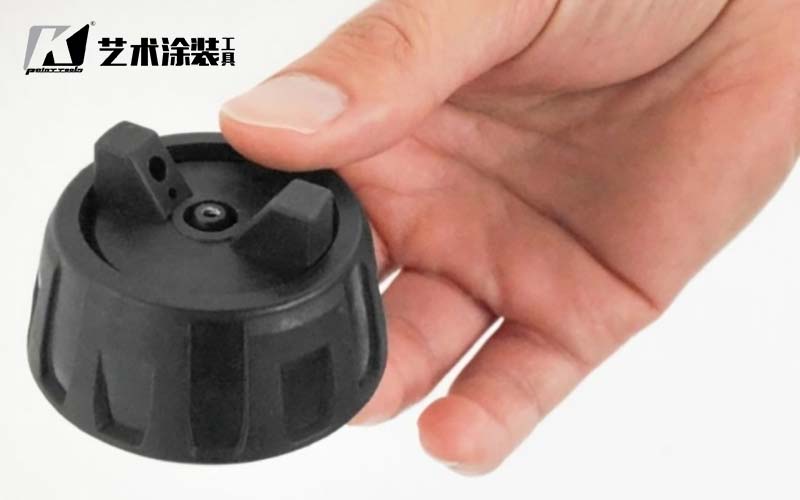
Spray Gun – Nozzle
Commonly made of high quality tungsten carbide, nozzles are classified in terms of orifice size. The amount of paint that flows through the sprayer depends on the size of the tip and the pressure setting.
There are different nozzle sizes depending on the type of paint to be used. For example, lacquers, stains and enamels are light coatings that are sprayed with small diameter tips, while exterior latex paints are much heavier coatings that require larger diameter tips.
Some sprayers are designed to accept one or two specific nozzle diameters, typically 2 and 2.5mm, for less viscous and more viscous paints, respectively. These diameters are suitable for solvent and waterborne paints, varnishes, primers, clear lacquers, wood preservatives, and vehicle base and top coats. However, these diameters should not be used to spray acid and alkaline substances, particulate materials, latex paints, or paints that do not drip or spatter.
a) Dilutions of the material
Even when the proper tips are used, most paints must be thinned before spraying. Since the paint can label does not always contain thinning instructions, some sprayer manufacturers include a viscosity gauge in their system to guide the user on how to achieve the proper viscosity.
The technique of using the viscosity meter is simple. First, the paint is placed in an appropriate container and shaken gently until properly mixed. Then, the viscosity meter shown in the figure below is fully immersed in the paint container, and then raised to let the paint drain out of its hole.
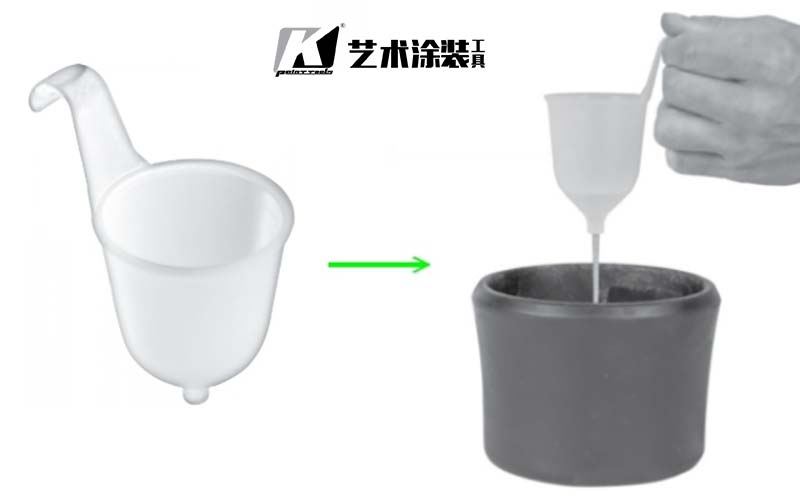
Paint viscosity meter
Using a stopwatch, the time it takes for the paint to flow through the meter hole is measured. As soon as the continuous flow is interrupted, the timer stops. This is the dripping time measured in seconds, which must be adjusted to the one described in the following table. If not, the paint is thinned again and the measurement process is repeated until the recommended drip time is achieved.
b) Spray patterns
Depending on the orientation of the surface to be painted and the amount of paint to be used, spray guns offer us several alternatives. On the one hand, the nozzle-air cap unit can be adjusted to achieve three different spray formats. Simply loosen the air cap retainer and rotate the air cap to the desired position, as shown in this figure.
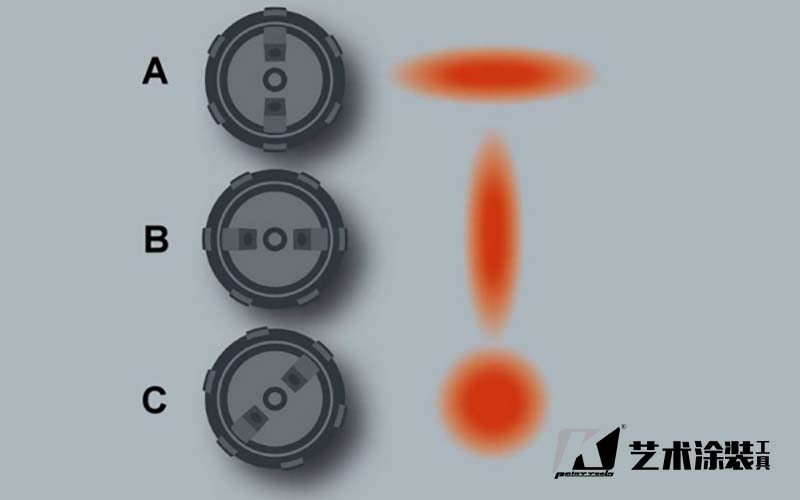
Air cap-nozzle unit adjustment
In this way, we achieve three different spray patterns:
A – Horizontal fan jet: for vertical surfaces.
B – Vertical fan jet: for horizontal surfaces.
C – Circular jet: for corners and edges, as well as for hard-to-reach surfaces.
It is also possible to regulate the amount of paint that we want to apply. To do this, turn the knob indicated with the green ring in the following figure to the right (more quantity) or left (less quantity).
When is it recommended to use an electric paint sprayer?
In accordance with all the features and advantages that we have just pointed out, the use of a paint spray gun is better adapted for some occasions than others. If we are undecided, we can consult the following infographic recommended by the experts that will serve as a guide.
Tips for using an electric paint sprayer
Use:
· When a uniform, streak-free finish is a must.
· When a large space is covered, for example, a sports/commercial/institutional building or hall.
· To paint all types of furniture.
The fine mist spray gets into nooks and crannies that brushes and rollers can't reach.
· When painting a room or an empty house.
· When only walls, ceilings, and trim are painted in a room or occupied dwelling.
Not use
· On small jobs or if you don't have a suitable spray area.
· If you have little amount of paint, since sprayers use more paint than traditional rollers and brushes.
· If you don't want a lot of prep work, since everything has to be covered with tape.
· If you don't want/don't have time for the cleaning process.
Disassembling and cleaning a paint sprayer is more time consuming than cleaning brushes, rollers and trays.
Sprayer Tips and Patterns:
Sprayers are rated for the tip size or sizes they can support. A sprayer's tip size sometimes refers only to the size of the opening, as in a .015 tip. Other times, it indicates two things at once—both the fan size (in inches) and the size of the tip opening. For example, a 515 tip sprays paint in a 5-inch diameter out of tip opening that measures .015 inches.
Stains require smaller tip sizes and less pressure, while paints and heavier coatings need larger tip sizes and more pressure. Consider the jobs you will be tackling, and for each sprayer option you consider, pay attention to its maximum recommended tip size. The greater the maximum recommended tip size, the more finish the sprayer can output per minute.
A paint sprayer's spray pattern is the shape in which the tool outputs the finish. The best paint sprayers are able to spray in multiple patterns: round, horizontal, and vertical. Having these options available means you can switch from spraying a wide fan across a surface to a fan of the same width moving up-and-down without having to turn the sprayer.
Each tip size comes in multiple spray-pattern widths. Widths can vary from about six to 14 inches wide. Smaller surfaces, like fence rails, call for a smaller pattern width. Ceilings, walls, and larger surfaces call for a larger pattern width.
Tips can be standard or reversible. The difference? A reversible tip can be unclogged easily by turning it around and blowing out the blockage.















